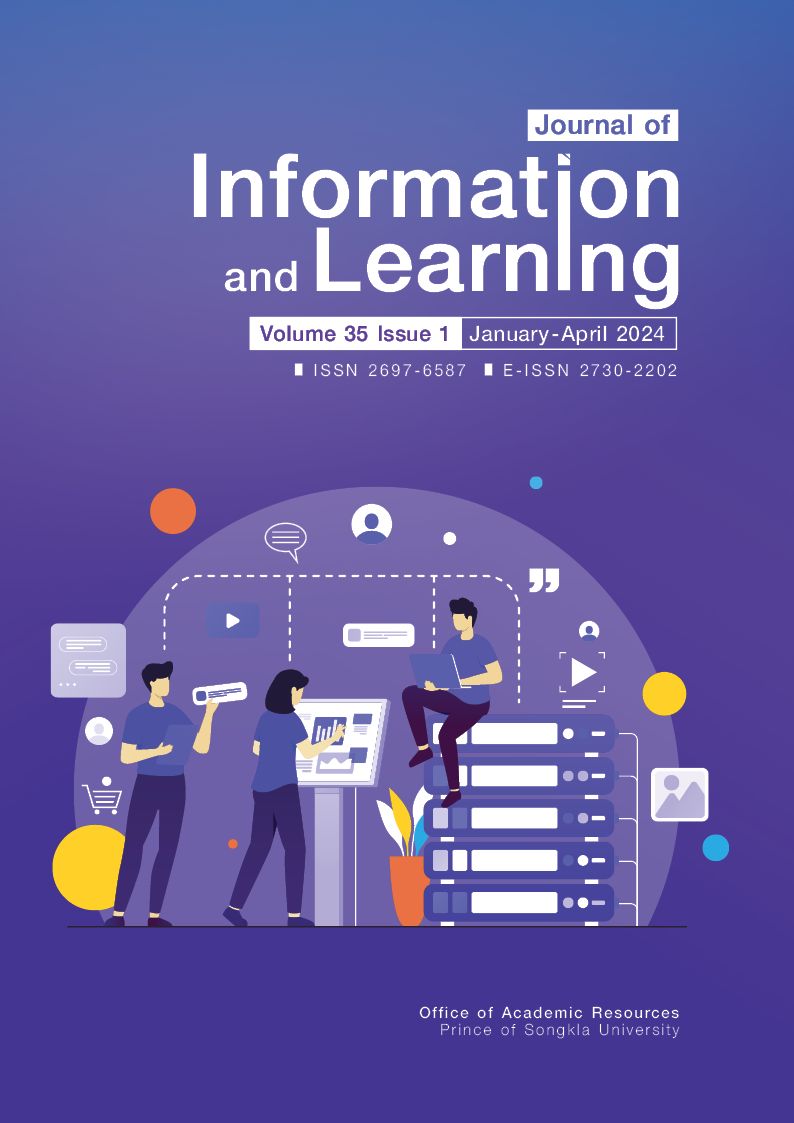การพัฒนาโมเดล 3 มิติ ตัวอักษรภาษาไทดำด้วยเทคโนโลยีความเป็นจริงเสริมที่ส่งเสริมผลสัมฤทธิ์ทางการเรียนภาษาไทดำของชุมชนไทดำ อำเภอเชียงคาน จังหวัดเลย
Main Article Content
บทคัดย่อ
การวิจัยครั้งนี้มีวัตถุประสงค์ 1) เพื่อสร้างโมเดล 3 มิติ ตัวอักษรภาษาไทดำด้วยเทคโนโลยีความเป็นจริงเสริมของชุมชนไทดำ อำเภอเชียงคาน จังหวัดเลย 2) เพื่อศึกษาผลสัมฤทธิ์ทางการเรียนโมเดล 3 มิติ ตัวอักษรภาษาไทดำด้วยเทคโนโลยีความเป็นจริงเสริม และ 3) เพื่อประเมินความพึงพอใจที่มีต่อโมเดล 3 มิติ ตัวอักษรภาษาไทดำด้วยเทคโนโลยีความเป็นจริงเสริม กลุ่มตัวอย่างที่ใช้ในการศึกษาในครั้งนี้ ได้แก่ ประชาชนวัยเด็กที่มีอายุระหว่าง 7-12 ปี และวัยรุ่นที่มีอายุระหว่าง 13-20 ปี ในชุมชนไทดำ อำเภอเชียงคาน จังหวัดเลย จำนวน 48 คน เครื่องมือที่ใช้ในการวิจัย ได้แก่ โมเดล 3 มิติ ตัวอักษรภาษาไทดำด้วยเทคโนโลยีความเป็นจริงเสริม จำนวน 39 ตัวอักษร แบบประเมินคุณภาพโมเดล 3 มิติ แบบทดสอบวัดผลสัมฤทธิ์ทางการเรียนโมเดล 3 มิติ ตัวอักษรภาษาไทดำก่อนและหลังใช้งาน และแบบประเมินความพึงพอใจโมเดล 3 มิติ ตัวอักษรภาษาไทดำ สถิติที่ใช้ในการวิเคราะห์ข้อมูล ได้แก่ ค่าเฉลี่ย ส่วนเบี่ยงเบนมาตรฐาน และการทดสอบสมมติฐานแบบกลุ่มเดียว (t-test dependent) ผลการวิจัยพบว่า 1) การสร้างโมเดล 3 มิติ ตัวอักษรภาษาไทดำ โดยใช้งานผ่านแอปพลิเคชัน AR อักษรภาษาไทดำ ขนาดของไฟล์ 176 เมกะไบท์ และมีคุณสมบัติที่ช่วยให้ผู้ใช้สามารถมองเห็นภาพเป็นวัตถุเสมือนจริงในสภาพแวดล้อมจริงได้ในรูปแบบ 3 มิติ มีผลการประเมินคุณภาพโมเดล 3 มิติ ตัวอักษรภาษาไทดำภาพรวมอยู่ในระดับมากที่สุด (M = 4.75, SD = 0.31) 2) ผลสัมฤทธิ์ทางการเรียนของผู้เรียนหลังเรียนด้วยโมเดล 3 มิติ ตัวอักษรภาษาไทดำสูงกว่าก่อนเรียนอย่างมีนัยสำคัญที่ระดับ .05 3) ผลความพึงพอใจของผู้เรียนที่มีต่อการเรียนด้วยโมเดล 3 มิติ ตัวอักษรภาษาไทดำภาพรวมอยู่ในระดับ มาก (M = 4.46, SD = 0.14)
Article Details

อนุญาตภายใต้เงื่อนไข Creative Commons Attribution-NonCommercial-NoDerivatives 4.0 International License.
Journal of Information and Learning ดำเนินการโดยสำนักวิทยบริการ มหาวิทยาลัยสงขลานครินทร์ วิทยาเขตปัตตานี บทความที่ได้รับการตีพิมพ์ในวารสารได้รับความคุ้มครองตามกฎหมายลิขสิทธิ์ โดยเจ้าของลิขสิทธิ์จะมีสิทธิในการทำซ้ำ ดัดแปลง และเผยแพร่งานบทความ ทั้งรูปแบบอิเล็กทรอนิกส์ การทำฉบับสำเนา การแปล และการผลิตซ้ำในรูปแบบต่างๆ ลิขสิทธิ์บทความเป็นของผู้เขียนและสำนักวิทยบริการ มหาวิทยาลัยสงขลานครินทร์ วิทยาเขตปัตตานี วารสารฯ ขอสงวนสิทธิ์ในการพิจารณาตีพิมพ์ตามความเหมาะสม รวมทั้งการตรวจทานแก้ไข การปรับข้อความ หรือขัดเกลาภาษาให้ถูกต้องตามเกณฑ์ที่กำหนด สำหรับผลการวิจัยและความคิดเห็นที่ปรากฏในบทความถือเป็นความคิดเห็นและอยู่ในความรับผิดชอบของผู้เขียน
เอกสารอ้างอิง
Agata, D., Yuniarti, H., & Adison, A. (2021). Teaching English vocabulary to young learners via augmented reality learning media. Beyond Words, 9(2), 91-99. https://doi.org/10.33508/bw.v9i2.2772
Chochaiyatich, R. (2021). The development of learning media by using augmented reality technology on library services introduction of The Central Library of Srinakharinwirot University [Master’s thesis, Srinakharinwirot University]. DSpace JSPUI. http://ir-ithesis.swu.ac.th/dspace/bitstream/123456789/1476/1/gs592130005.pdf
Ersani, C. Y. (2023). The effect of using augmented reality with storytelling on young learners’ vocabulary learning and retention. Novitas-Royal, 17(1), 62-72. https://files.eric.ed.gov/fulltext/EJ1389077.pdf
Krejcie, R. V., & Morgan, D. W. (1970). Determining sample size for research activities. Educational and Psychological Measurement, 30(3), 607-610. https://doi.org/10.1177/001316447003000308
Krutvee, N., Chalopagorn, P., Geawprasert, G., & Pornudomthape, S. (2021). The development of 3D model application for learning about basic chemistry laboratory equipment using augmented reality techniques. Dhonburi Rajabhat University Journal, 15(2), 78-94. https://so02.tci-thaijo.org/index.php/journaldru/article/view/253794
Kurt, S. (2017, August 29). ADDIE model: Instructional design. Educational Technology. https://educationaltechnology.net/the-addie-model-instructional-design/
Malithong, K. (2005). Theknōlōyī læ kānsư̄sān phư̄a kānsưksā [Technology and communication for education]. Arun Printing Limited Partnership
Munkong, V. (2022, July 9). Prawat chāo thai dam [History of the Tai Dam people]. Museumthailand. https://www.museumthailand.com/en/3442/storytelling/ชาติพันธุ์ไทดำ/
Musaarong, H., Thepnarong, K., & Dumrongrit, D. (2021). The development of augmented reality media learning on local music using the augmented reality technology. Yala Rajabhat University. https://wb.yru.ac.th/bitstream/yru/6489/1/2.PDF
Prasartkul, P. (2021, October 20). Telephone: The 5th factor for living. The Prachakorn. https://www.theprachakorn.com/newsDetail.php?id=523
Sahaphong, T. (2019). The development of augmented reality application "navel of Isan", Kosum Phisai District, Maha Sarakham Province. Maha Sarakham University. http://research.rmu.ac.th/rdi-mis//upload/fullreport/1632638201.pdf
Silpcharu, T. (2020). Kānwičhai læ wikhro̜ khō̜mūn thāng sathiti dūai SPSS læ AMOS [Statistical data research and analysis with SPSS and AMOS] (18th ed.). Business R&D.
Thavorn, S. (2013). Phonological variation and change consonant and vowel variation phonological variation factors [Master’s thesis, Mahidol University]. TU Digital Collections. https://digital.library.tu.ac.th/tu_dc/digital/api/DownloadDigitalFile/dowload/57191
Thongchum, K. (2018). The development of KANJI application with augmented reality technology by association image method [Master’s thesis, Thai-Nichi Institute of Technology]. TNI Library. http://library.tni.ac.th/thesis/upload/files/Thesis%20MIT%202018/Kanyarat%20Thongchum%20Thesis%20MIT%202018.pdf
Tulgar, A. T., Yilmaz, R. M., & Topu, F. B. (2022). Research trends on the use of augmented reality technology in teaching English as a foreign language. Participatory Educational Research, 9(5). 76-104. http://dx.doi.org/10.17275/per.22.105.9.5
Virtual Reality Society. (2022, July 9). Augmented reality – What is it?. Virtual Reality Society. https://www.vrs.org.uk/augmented-reality/


